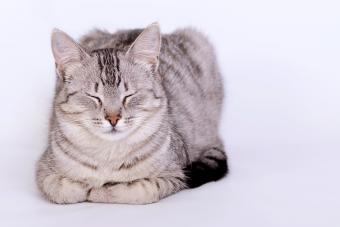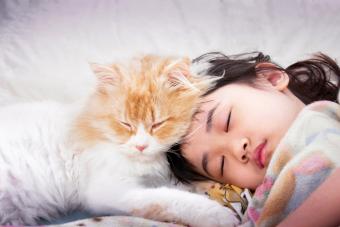
Cats are notorious for contorting their bodies into some pretty awkward sleeping positions. But the way your cat sleeps isn't just entertaining; it could say a lot about their mood or even their health. For example, if your cat sleeps on their back with their belly up, it means they feel completely safe, whereas sleeping under the bed could be a sign of illness or anxiety. Discover what your cat's sleeping position says about them, along with what they think about you.
Decipher the Meaning of These Common Cat Sleeping Positions
Your cat can't verbally tell you if they're happy, hot, stressed, or sick. However, paying attention to their favorite sleeping positions can give you some insight into how they're feeling.

Created by LoveToKnow / Images from Getty Owned by LoveToKnow, copyright LoveToKnow Cat sleeping positions infographic
"Loaf" Position
Aha, the infamous cat loaf. You know the pose; they sit with their paws and tail tucked under their body, resembling a loaf of bread. Cats who do this generally feel comfortable and safe, but haven't entirely let their guard down. They don't feel like they'll need to defend themselves with their claws, but they could spring into action any minute if the need arises. This pose also allows them to maintain a toasty (pun intended) warm temperature.

By Your Head
A common cat sleeping position is on your pillow or around your head. Even though this can be annoying, it's a sign your cat deeply loves and trusts you. Being up by your head allows them to bask in the scent of your hair and even mark you with their own scent through the glands in their cheeks. It's also seen as a very safe place, so they could be seeking security from other pets in the house. Plus, your head is warm.

Unfortunately, a cat sleeping across a person's face can be dangerous, particularly for babies and young children or adults with respiratory issues or cat allergies. If your cat's sleeping position is interfering with your health, it might be best to keep them out of the bedroom, no matter how much they love you.
In the Sink
Most cats hate water, so why is your cat sleeping in the sink? It could be that they're hot. The cool porcelain or ceramic surface of the sink is a great place for your feline friend to release some heat. Not to mention, bathrooms are typically quiet, so it's possible your cat may just be looking for a serene place to sleep.

Curled in a Ball
Many cats curl themselves into a tightly wound ball to sleep, which is a relaxed cat sleeping position. The curled-up posture allows them to protect their vital organs while retaining heat. A cat in this pose intends to sleep for a while, and they clearly feel safe enough to do so!

Paws Covering Face
Along with the curled ball position, cats sometimes cover their face with paws. This is often to keep themselves warm or shield their eyes from the light. Cats love laying in the sun, so it's possible the bright sunshine might be interfering with their cat nap. Think of it as a makeshift sleep mask or "do not disturb" sign.

Head Pressed Against a Wall
If your cat continually falls asleep with their forehead pressed against the wall or another hard object, it could be a cause for concern. Head pressing is an animal behavior generally related to neurological conditions, such as head trauma, encephalitis, or a brain tumor. You'll also see other signs like pacing, getting stuck in corners, circling, incoordination, or seizures. So, if your cat falls asleep like this once and they're otherwise acting fine, don't panic. But if you notice it consistently, have them examined by your vet.

Eyes Slightly Open
Seeing your cat sleep with their eyes slightly open can be alarming, but it's a fairly common occurrence. Experts suggest it's more common in older cats. When cats are just falling asleep or in a light sleep state, their eyes can stay partially open. You might even see their third eyelid over the corner of their eye.

Under the Bed
Have a cat who falls asleep under the bed? It's possible they're hiding out of fear. Scared or stressed cats tend to find solace in concealed places, such as the space underneath a bed. So, if you just had visitors over or a new pet is making your kitty feel unsettled, that could explain the under-the-bed sleeping position. Cats who are feeling ill also tend to hide in hard-to-reach places.

Stretched Out
If you see a whole lot of your cat's cute belly while they sleep, that means they feel incredibly relaxed. Sleeping on their back with their limbs outstretched is a very vulnerable position for cats; they're putting their vital organs at risk and aren't in any place to flee from predators. So, if your cat likes to sprawl out when they nap or drape their body across the furniture, know they feel very safe in their environment.

Sideways Sleeper
Cats who get their beauty sleep while on their side generally feel secure and calm. Even though they're not completely outstretched, they're still fairly exposed. They're likely getting some deep sleep in this relaxed position. However, if your cat is lethargic or not acting like their usual self and lying on their side, you should seek emergency veterinary care.

On Your Feet
Whether you're lounging on the couch or in bed, a cat who sleeps on your feet is most likely trying to keep you safe. This sleeping position gives them a wide vantage point to see any approaching threats. Even while catching some Zs, your feline friend wants to protect you.

Cuddled with Another Pet
Cats generally only sleep with another cat, dog, or other pet if they're bonded to them. So, if your cat is sleeping next to or cuddled with an animal housemate, it means they really trust this friend. However, the opposite could be true, and no longer sleeping together could mean there's bad blood between your pets. Worse, it might signal that one of the pets isn't feeling well and wants to be left alone.

Cat Sleeping Positions Explained
Just like how some people sleep on their side, while others are more comfortable on their back, cats have their distinct preferences. However, their security level, comfort, and health can play a role in the way they sleep. If you notice a sudden shift in your cat's sleeping position, something might be up. Keep a close eye on their other habits and report any changes to your vet.







